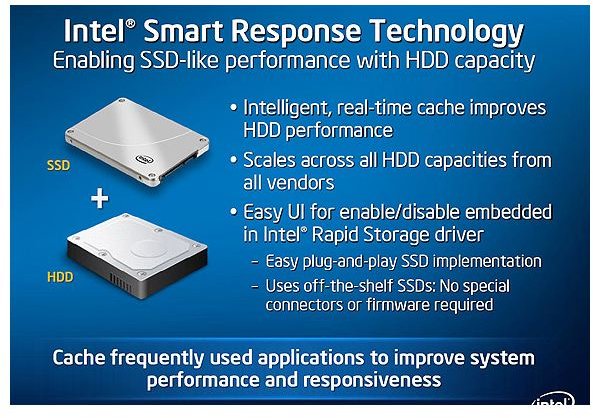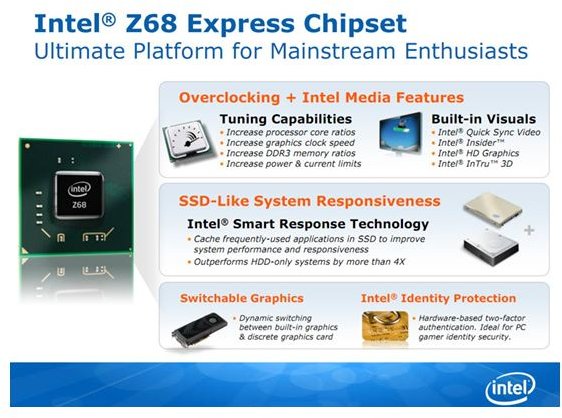Intel Smart Response: A Layman's Explanation
A New Use for Flash Memory
Flash memory, as used in desktop and laptop computers, is usually given one of two jobs. Most frequently it is used as RAM, which provides extremely quick short-term memory that makes it possible for programs to retain information without accessing the hard drive. In the last few years it has also been used in hard drives, called solid state drives, for long-term memory. These drives are expensive, but generally much quicker than mechanical alternatives.
These two jobs are far from the only uses, however. Recently, Seagate introduced a new hard drive called the Momentus XT which includes both a traditional mechanical drive and also a sizable (4GB) memory chip. What the company hoped to offer was a drive that could provide the quick response times of a solid state drive but also keep costs down, so consumers didn’t have to pay much to enjoy that benefit.
Arguably, this was a success. The Momentus XT proved capable of providing very quick response times in many situations, and was about $20 to $30 more than a comparable mechanical drive. But now, Intel has taken this concept to the extreme with a new feature called Intel Smart Response, which makes it possible to use a small solid state drive as a system cache.
The Nitty-Gritty Details
Intel Smart Response is a software feature currently enabled only on Intel Z68 based motherboards, although we’ll almost certainly see it introduced on future chipsets as well. The term “software feature” means it is not enabled by any specific hardware on the motherboard, but rather by the driver software. Theoretically this feature could become available on other recent Intel motherboards, via a hack if not through official Intel support.
Smart Response turns up to 64GB of space on a solid state drive into a cache. What does that mean? It means that read/write data is transfered to and from the solid state drive when possible, which in turn provides better performance. That data is then transfered to the mechanical hard drives. No data is stored on the cache long-term. The data is simply passing through, or kept temporarily so that it can be quickly recalled.
How does Smart Response know what you might want to access? Because it watches your every move! With this feature enabled, the driver monitors user activity and prepares information on the cache that it believes the user is likely to want. Let’s say, for example, that you open a number of documents frequently for work. That data will be put in the cache so that the files open more quickly in the future. This isn’t drastically different from how Windows 7 handles RAM - but a solid state drive can store a lot more data and, perhaps more importantly, it’s persistent. Your cached data doesn’t disappear when you turn your computer off.
Pick Your Mode

There are two different modes of operation available with Smart Response. You can select the mode in the software utility that comes with the motherboard drivers.
Maximized Mode is write-back. This means that data is written to the cache but isn’t instantly transferred over to the approriate hard drive as well. Instead, the cache drive deals with moving the data whenever it has the chance. This can provide a bit of a performance benefit, but if the drive suddenly loses power some of the data in the cache may be lost because it hasn’t been properly sorted and placed.
Enhanced Mode is write-thru. This means that data is written to the cache, then immediately to the approriate hard drive. This does not provide the maximum performance benefit because the cache will have to busy itself with immediately writing data to other drives, rather than potentially storing that data and writing it later. However, this prevents data loss.
Real World Performance Benefits
So, does this feature really improve performance? That depends.
Remember, even if this is a very large cache, it’s still a cache. It has a limited amount of storage space to utilize, so some priority must be placed on frequently used programs, rather than those that are not used often. In some situations, such as software load times and system boot times, the performance benefit of Smart Response was impressive, with load/boot times being postively impacted by up to 50 percent when compared to a mechanical drive.
These benefits were replicated in workload tests, as well, such as those emulating web or data server usage. However, Smart Response has problems with consistency because of the fact that the cache does have a limit. Sometimes a program might load very quickly, but if it has been forced out of the cache by other data, it will suddenly load at a more mundane pace. Increasing the amount of space provided for the cache will make this a less common issue, but will also, of course, increase the price of the solid state drive used.
Should I Care?
There’s no doubt that this feature can result in a significant performance improvement. The question is if that improvement is worthwhile compared to the alternatives.
Here’s the thing. You’re going to need a solid state drive, and that will be fairly expensive no matter what you do. In order to obtain the best results you’ll probably want a 40GB drive, and those are usually priced around $99. This still does not guarantee that you’ll receive the benefits of the SSD all the time, however - what has been cached will load quickly, and what hasn’t been cached - won’t.
Alternatively, you could buy an 80GB SSD for about $180 and load the programs that are most important on it. This will give you excellent performance all of the time. No guessing.
In my opinion, that dramatically reduces the appeal of Smart Response. There are still some benefits to be had here - but I believe this feature is only going to appeal to a very slim selection of consumers who want SSD performance but simply can’t afford the larger drives.
References
- Anandtech: Intel Z68 Chipset & Intel Smart Response - https://www.anandtech.com/show/4329/intel-z68-chipset-smart-response-technology-ssd-caching-review/1
- All images are from Intel press materials.
